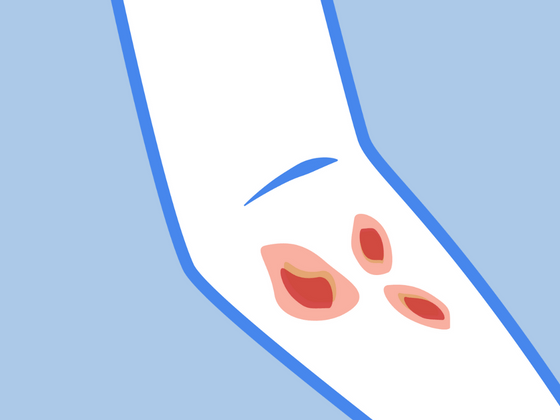Superficial necrolytic dermatitis, also known as hepatocutaneous syndrome, is a rare degenerative skin disorder in dogs characterized by painful skin lesions. The cutaneous lesions most commonly occur on the face, genitals, foot pads, and pressure points of the limbs and are often seen as an indication that your dog is suffering from some kind of internal organ disorder. The disorders most often associated with superficial necrolytic dermatitis include diabetes mellitus and liver disease.
Throughout this blog, we will cover everything you need to know about:
-
The symptoms of superficial necrolytic dermatitis in dogs
-
What causes contact superficial necrolytic dermatitis in dogs
-
How to treat and help relieve symptoms for your furry friend
Read on to find out more about how superficial necrolytic dermatitis develops in dogs and what can be done to manage your pup's symptoms and keep them as happy and healthy as possible.
What Causes Superficial Necrolytic Dermatitis?
Although the exact cause of superficial necrolytic dermatitis (SND) is not fully understood, several factors are believed to contribute to its development.
Liver Disease
SND can sometimes occur in association with disorders of the internal organs, particularly the liver, kidneys, and pancreas. Liver disease is a common cause of the cutaneous lesions seen in dogs with this degenerative skin disorder. The liver plays a crucial role in our metabolism and breaking down proteins, carbohydrates, and fats. Liver dysfunction can lead to abnormalities in these metabolic processes, thus contributing to the development of skin lesions and superficial necrolytic dermatitis in dogs.
Pancreatic Dysfunction
SND has been linked to abnormalities in pancreatic function, such as insulin resistance and glucagon excess. Insulin resistance occurs when the body's cells do not respond properly to insulin, leading to elevated blood sugar levels. Over time, these pancreatic abnormalities can contribute to the development of diabetes mellitus in dogs, a condition where the body is unable to regulate sugar in the bloodstream.
Nutritional Imbalances
Some studies suggest that nutritional deficiencies, particularly in amino acids such as methionine, cysteine, and tryptophan, may be associated with SND. These amino acids are involved in various metabolic processes and areessential for repairing tissue damage and maintaining overall skin health. Imbalances in these nutrients may also contribute to insulin resistance and glucose intolerance, increasing the risk of diabetes mellitus.
Symptoms of Superficial Necrolytic Dermatitis in Dogs
Is your dog struggling with sore, itchy skin? If you notice any of the following signs, take your pup to see a veterinarian.
-
Crusted skin lesions
-
Red patches of skin
-
Hardened skin (hyperkeratosis)
-
Ulcerated skin
-
Scaly skin
-
Pus
-
Hair loss (alopecia)
-
Cracked foot pads
-
Loss of toenails
-
Weight loss
-
Frequent urination
-
Lethargy
-
Excessive drinking
Treatments for Superficial Necrolytic Dermatitis
While superficial necrolytic dermatitis can vary widely in severity, it is generally considered a serious condition, and the prognosis is poor for most dogs. Treatment, therefore, focuses on stabilizing the condition and keeping your pup as comfortable as possible rather than searching for a cure.
Treatment for superficial necrolytic dermatitis should focus on two areas: managing the underlying metabolic abnormalities and managing the skin lesions. As SND is a complex degenerative skin disorder with various underlying factors, treatment options will vary depending on the patient's case and specific needs.
Addressing Underlying Metabolic Abnormalities
Amino Acid Infusions:
The most effective form of treatment for dogs with SND and low plasma amino acid concentrations is an intravenous amino acid infusion (AAI). These infusions help the body repair tissue and skin damage and provide your pup some relief from the painful symptoms of superficial necrolytic dermatitis. However, if your furry friend requires further amino acid infusions, this can become costly as the treatment requires hospitalization and repeated central-line catheters.
Surgery and Medication:
A liver biopsy or surgery may be required to explore the cause of the skin disease and remove any glucagon-secreting and cancerous tumors associated with glucagonoma syndrome and diabetes mellitus. Medication may also be prescribed to treat any concurrent diabetes mellitus; however, diabetes found with SND is typically insulin-resistant and hard to treat.
Diet:
Providing a nutritious and balanced diet is essential to combat the nutritional deficiencies associated with SND. Diets high in fatty acids, vitamins, and zinc are recommended to help ease symptoms and encourage the skin to heal.
Symptomatic Management of Skin Lesions
Once you have confirmed the cause of your dog's symptoms, it is time to turn your attention to wound care and keeping your pup comfortable. Careful wound management is required for dogs with SND to avoid secondary skin infections. The affected areas should be cleaned regularly with antiseptic, and skin lesions should be treated with topical treatments under the guidance of a veterinarian.
Topical treatments containing manuka honey and zinc oxide are particularly effective in relieving the inflamed and irritated skin associated with dermatitis. In severe cases, affected dogs may be required to wear protective clothing to promote healing and help prevent further trauma to the skin.
Heal Your Dog's Superficial Necrolytic Dermatitis Today
If your dog is suffering from superficial necrolytic dermatitis, understanding the causes and treatments is essential for their well-being. Follow these tips to help you identify the symptoms of this degenerative skin disorder in your dog and ensure they get the help they deserve right away.








